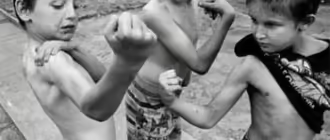It is believed that the minimum number of workouts for a powerlifter is two. Practical observations indicate that two times a week is already enough to keep the body in a somewhat active state. But this number should be treated as a minimum. Anything less is already self-deception! The most successful training option is when an athlete can afford to spend time training 3-4 times a week. At this rate, the body will be sufficiently loaded for progression, but will also have a reserve of time for recovery.
Training can be done either in the full body workout mode or according to the so-called split system – when the load is distributed over different parts of the body during several workouts. Usually, for convenience, athletes stick to weekly cycles and divide their body according to the principle of “pull-push”, “upper-lower” and so on. Such a split can break up training into separate muscle groups. But we should not forget that while we work out our entire body in this way, a fairly long period of time may pass between trainings of the same muscle group. That is, we need to correlate the number of workouts that do not involve a specific muscle group with the time interval between trainings of this muscle group.
At the initial stage of visiting the gym, I would recommend all athletes to work out the whole body. This period can last for 4-6 months, until your muscles get used to the loads and simply learn to tense up. Sooner or later, a regular gym visitor will feel that his muscles no longer have enough of the amount of work that he can give them during one workout. After all, while you work, for example, your legs, there will be no strength or time left for your arms and back. For this, workouts begin to be divided into muscle groups.
“Top – Bottom”
It’s very simple. The body is divided into the upper and lower parts. And if even simpler, then into legs and everything else. It would seem that the division is unfair, since in one workout you need to work only on the legs, and in the second both on the torso and arms. But the answer suggests itself after we think about where in our body the bulk of the muscles is located – in the legs. Legs always require increased attention to themselves, since they contain a very large volume of muscle tissue, which is quite difficult to work out well. This is why all advanced athletes put leg training on a separate day. And often they even divide according to the principle that we will consider further – “pull-push”.
“Push-pull”
There are muscles with which an athlete can pull something towards himself, and there are muscles that are activated when an athlete pushes something away. For example, pull-ups, deadlifts, barbell and dumbbell lifts are all exercises for the muscles that pull. Squats, presses, extensions are all exercises for the muscles that push.
It should be remembered that when building a workout, the exercises that require the athlete to put maximum effort or concentration first. That is, those where the weight of the projectile is maximum. For example, during a workout that will include squats with a barbell on the shoulders, bench presses and pull-ups, the exercises should be put in exactly the order in which I wrote, since we squat, as a rule, with a weight that exceeds the one we can press. And we pull up with our own weight. And if you are not a fat-covered 150-kilogram freak who is able to pull up 20 times, we put pull-ups in last place!
Over time, even such a division of training as “pull-push” or “upper-lower” becomes insufficient for high-quality training of the whole body, and we begin to use more sophisticated splits. One of the typical three-day splits may look like this:
1. Chest, triceps, deltoids
2. Back, biceps, forearms
3. Legs
If a beginner bodybuilder really wants to cheat and load his arms more often so that his biceps are bigger, he can swap the biceps and triceps workouts in this split. And this way it turns out that he trains his arms not once, but twice a week. Arms are not a very large muscle group, which allows you to train them more than once a week. And the additional load appears due to the fact that when training the back with the split option described above, the biceps are also very heavily loaded, and then, when the athlete begins to train the biceps, his two-headed friend is already tired and cannot do the same amount of work that he could have done if he had been in the program separately from the back. The same applies to the triceps in conjunction with the chest. When training the chest, we often do various presses, in which the triceps are actively working.
Over time, the split can be modernized without being tied to weekly cycles and only take into account periods for the recovery of specific muscle groups. For example, train legs once every 10 days, and arms once every 4 days. But for this, you will simply have to live in the gym! Think about how much you need such a lifestyle if you are not a fitness instructor and are not in the gym every day for work.






